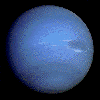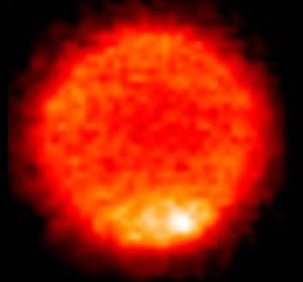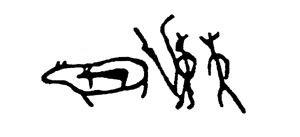Neptune
and its strange moons


The orbit of Uranus was calculated using Kepler's and Newton's laws. The calculations took several years. At that time computers were people who did the calculations and they had to be paid. French astronomer Alexis Bouvard undertook the task. He used both the modern observations from 1781, and also the early observations of Flamsteed in 1690, Bradley, Mayer in 1756, and Le Monnier. At least 22 observations of Uranus had been made from 1690 to 1772 but it had not been recognised as a planet. Bouvard found that he could not obtain an orbit which would fit all the sets of observations during that 130 years that he was able to obtain his data. There were two possibilities. One was that the earlier observational data was unreliable - some of Pierre Charles Le Monnier's records had been made on a paper bag that had contained his wig powder. The other possibility, was, since allowance had already been made for the influence of Jupiter and Saturn, that there must be another large planet beyond Uranus affecting its orbit and waiting to be discovered. If so, where was it.
In 1841 a young Cambridge mathematics student, John Couch Adams, resolved to calculate the position of the unknown planet, but he did not have the time to apply himself to the task until 1843. By September 1845, he had a result that indicated the place in the sky where the missing planet could be found. He took his results to the Astronomer Royal George Biddel Airy, who had been his professor at Cambridge. Airy did not trouble himself to come to the door, but sent a message that he was at supper and could not be disturbed. Adams left his paper with the servant who put it away in Airy's study.
Meanwhile in Paris, the astronomer, Urbain Jean Joseph Le Verrier was working on the same problem, unaware of Adams' paper since it had been ignored by Airy. At the end of 1845 he presented his paper. Airy received a copy in England and it stimulated him to search his shelves for Adams's paper. The two papers were very close in pinpointing the position of the unknown planet. The Director of the Cambridge Observatory, James Challis, was requested to search for the planet, but could not find any charts for that region of the sky. Meanwhile, Le Verrier had revised and updated his paper and in September 1846, sent a copy to Encke at Berlin together with a letter asking if he could help in searching for it. Encke asked two of his assistants, Heinrich D'Arrest and Johann Galle to do this. They already had a recently compiled map of that part of the sky. Galle called out the visible stars one by one while D'Arrest checked them on the map. Suddenly they come upon an unmarked object which at the moment looked like an 8th magnitude star. The next night they found it again, and subsequent checking showed it to be moving against the background of stars - they had found the missing planet! Adams had only been 2 1/2" out and Le Verrier even closer at less that 1" out in the position of Neptune. The discovery of the new planet was of great interest all over the world, but England, France and Germany squabbled over the claim to have been the first to have discovered it.
 Neptune is about 4,500 million miles from the Sun and its orbit takes 165 Earth years. Although it receives only about 1/900th as much sunlight as Earth, this is sufficent to significantly affect the planet's atmosphere with temperature variations consistent with seasonal changes. At present it is summer at Neptune's south pole which has been tilted towards the Sun for about 40 years. It has been discovered that the temperature there is about 10 degrees higher than the average temperature over the rest of Neptune which is minus 200 degrees Celsius. It is the warmer polar area that allows methane gas to seep out of the lower atmosphere to the surface.
Neptune is about 4,500 million miles from the Sun and its orbit takes 165 Earth years. Although it receives only about 1/900th as much sunlight as Earth, this is sufficent to significantly affect the planet's atmosphere with temperature variations consistent with seasonal changes. At present it is summer at Neptune's south pole which has been tilted towards the Sun for about 40 years. It has been discovered that the temperature there is about 10 degrees higher than the average temperature over the rest of Neptune which is minus 200 degrees Celsius. It is the warmer polar area that allows methane gas to seep out of the lower atmosphere to the surface.
Voyager 2 arrived here at the end of August 1989. Two moons were known, Triton and Nereid, six more were discovered and rings round Neptune and a strong magnetic field at an angle of 47 degrees to its axis. It took four hours for the information from Voyager 2 to reach Earth.
Neptune like the other gas giants, is mostly composed of the light gases, hydrogen and helium. But the abundance of methane in Neptune's upper atmosphere absorbs the red light from the Sun and reflects the blue light back into space, making Neptune, like Uranus, appear blue.
Neptune has the fiercest winds in the solar system. The winds blow at speeds up to 300 m.p.h. from east to west which is the opposite directions to the winds on the other gas giants. In the bands of clouds Voyager 2 showed a is a great dark whirling storm spot, rather like the great red spot on Jupiter and smaller storm whirls. There are also bright white clouds at a very high altitude. In 1994 the Hubble Space telescope showed that the storm spots seen by Voyager 2 in 1989, had changed, and had been replaced with different cloud formations.
Like Jupiter, Neptune has an internal heat source. Like the other gas giants, it is really a small star, too small for gravitation pressures to heat its core sufficiently for nuclear fusion to take place.

Neptune's largest moon, discovered by Lassell in 1846, is 1350 ± 5 kilometres in radius with a density of 2.075 ± 0.019. Its orbit is retrograde which means that it travels in the opposite direction to most of the bodies in the solar system. Its orbit round Neptune is irregular in other ways. Normally a planet's satellites orbit parallel to its equator, but the orbit of Triton is at an angle of 21 degrees to Neptune's equator. This means that Triton is unlikely to have formed from a disc of material round Neptune, so it must have been an independent planet, a Kuiper object, much like Pluto, dragged into orbit round Neptune.
Triton is pink and blue and it is geologically active with volcanos venting dust and gas. Part of the terrain has a young surface flooded with ice lava. Part of the surface is crisscrossed with faults, possibly grabens, that is sunken faults.
The surface temperature of Triton is very low - about 38K (water freezes at 273.15K, which is 0 degrees C). Triton is very bright - average albedo is 0.78. This is because the surface is covered by a pink methane and nitrogen frost. It has a polar cap of nitrogen ice which is probably seasonal. Triton has a thin nitrogen atmosphere, pressure 16 ± 3 m bar - a hundred thousandth of Earth's atmospheric pressure, but enough for thin clouds of nitrogen ice over the polar cap at a height of a few kilometres. The surface features on Triton are named after aquatic gods and places.
The satellites discovered by Voyager 2 in 1989, are all very dark objects.
In 2004, five more satellites - and one possible moon - have been discovered orbiting Neptune, bringing its tally of moons to 13.
Two orbit in the same direction as the planet rotates, while the orbits of the others are opposite to Neptune's spin.
The tiny outer satellites are probably captured asteroids. Cataclysmic events connected to the capture of Neptune's moon Triton were thought to have destroyed any outer satellites the planet once had.
The new moons, named S/2002 N1 to N4 and S/2003 N1, are in eccentric, tilted orbits. They are all between 30km and 50km in diameter.
An international team of astronomers searched for the satellites between 2001 and 2003 using the 4m Cerro Tololo Inter-American Observatory and the 3.6m Canada-France-Hawaii telescope.
The researchers used a technique to look for the new moons that was originally developed to detect very faint objects in the outer Kuiper Belt.
They also observed a sixth candidate moon, which they have named c02N4. This was discovered on 14 August 2002 and seen again at the Very Large Telescope (VLT) on 3 September 2002. But further attempts to spot this object failed.
The researchers say this could be Centaur - an object that has migrated from the outer Kuiper Belt. But its lack of movement relative to Neptune is more consistent with it being a satellite.
The satellites are unlikely to have condensed from material around Neptune. Instead, these so-called irregular moons may be the product of a parent body that collided with Neptune's moon Nereid and were then disturbed in their orbits by the capture of Triton from the Kuiper Belt.
 |